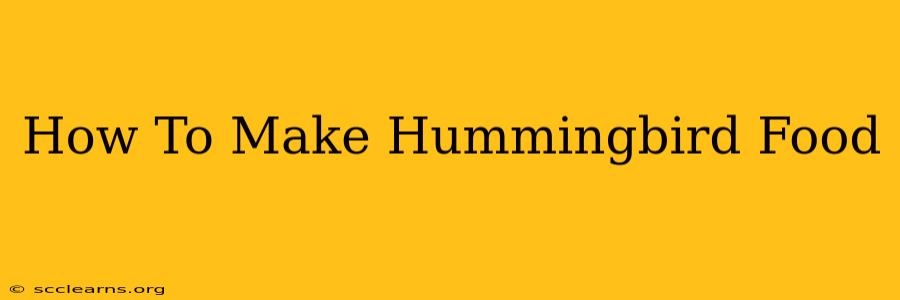Hummingbirds, with their dazzling speed and vibrant colors, are a delightful sight in any garden. Attracting these tiny jewels to your yard is easier than you think, and providing them with the right nourishment is key. Making your own hummingbird food is a rewarding experience, allowing you to control the ingredients and ensure your buzzing buddies receive the best possible sustenance. This guide will walk you through how to make hummingbird food safely and effectively.
Understanding Hummingbird Diet
Before diving into the recipe, it's crucial to understand what hummingbirds need. Their diet primarily consists of nectar, a sugary liquid found in flowers. While commercially available hummingbird food is readily available, making your own offers several advantages, including cost savings and the ability to avoid potentially harmful additives.
Key Ingredients for Homemade Hummingbird Nectar:
The foundation of a healthy hummingbird food recipe is simple: sugar and water. Avoid using honey, artificial sweeteners, or other additives. Honey can be harmful to hummingbirds, and artificial sweeteners provide no nutritional value.
The Simple Recipe: How to Make Hummingbird Food
This recipe is straightforward and yields a nectar solution that closely mimics the natural sugars found in flowers:
Ingredients:
- 1 cup granulated white sugar
- 4 cups water
Instructions:
- Combine: In a saucepan, combine the sugar and water.
- Heat: Gently heat the mixture over medium heat, stirring constantly until the sugar is completely dissolved. Do not boil. Boiling can change the chemical composition of the sugar, creating harmful compounds for hummingbirds.
- Cool: Allow the solution to cool completely before pouring it into your hummingbird feeders.
- Fill and Enjoy: Once cooled, carefully fill your hummingbird feeders. Remember to clean your feeders regularly to prevent mold and bacterial growth.
Tips for Success:
- Use clean containers: Cleanliness is paramount when making and storing hummingbird food. Use clean utensils and containers to avoid contamination.
- Proper Ratio: Sticking to the 1:4 ratio (sugar to water) is crucial. Too much sugar can be harmful, while too little won't provide enough energy for the hummingbirds.
- Fresh is Best: Change the nectar in your feeders every 3-5 days, especially in hot weather, to prevent spoilage. Discard any remaining nectar after this time.
- Red is Attractive: Hummingbirds are attracted to the color red. Choose feeders with red components to make them more visible to these tiny birds.
Choosing the Right Hummingbird Feeder
The type of feeder you use also impacts the success of attracting hummingbirds. Look for feeders that:
- Are easy to clean: Regular cleaning is essential to prevent disease.
- Have multiple feeding ports: This allows multiple hummingbirds to feed simultaneously, reducing aggression.
- Are durable and leak-proof: A well-made feeder will last longer and prevent spills.
Beyond the Basics: Seasonal Considerations
While the basic recipe works year-round, consider adjusting your approach based on the season:
- Summer: In hot weather, change the nectar more frequently to prevent spoilage.
- Winter: If you live in a region with freezing temperatures, bring your feeders indoors to prevent the nectar from freezing.
By following these simple steps and providing a clean, fresh supply of homemade hummingbird food, you'll be well on your way to enjoying the vibrant beauty of these amazing creatures in your own backyard. Remember, providing a safe and reliable food source is a crucial part of hummingbird conservation efforts. Enjoy the show!

